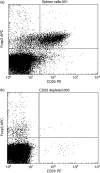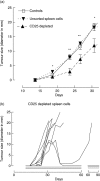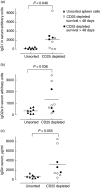Depletion of CD4+ CD25+ regulatory T cells inhibits local tumour growth in a mouse model of B cell lymphoma
- PMID: 18341610
- PMCID: PMC2384114
- DOI: 10.1111/j.1365-2249.2008.03642.x
Depletion of CD4+ CD25+ regulatory T cells inhibits local tumour growth in a mouse model of B cell lymphoma
Abstract
Regulatory T cells (T(regs)) may inhibit immunity against cancer. Induction and expansion of T(regs) in the immunosuppressive microenvironment created by a growing tumour appear to be one of the mechanisms by which it can evade host defence. We studied the impact of CD25+ T(regs) in a B cell lymphoma model in which Rag2-/- mice received adoptive transfer of wild-type spleen cells with or without CD25+ cells, and concurrently subcutaneous inoculation of the B cell lymphoma cell line A20. We also examined the effect of engaging the glucocorticoid-induced tumour necrosis factor receptor (GITR) - an approach reported previously to abrogate the suppressive effects of T(regs). Mice that received spleen cells depleted of CD25+ T(regs) showed significantly slower tumour growth and increased survival compared with mice that received unsorted spleen cells. The T(reg)-depleted group also had significantly more CD8+ T cells infiltrating the tumours and higher levels of serum immunoglobulin G subclasses. The anti-GITR treatment had no significant effect on tumour growth, survival or immunoglobulin production. In the CD25-depleted group four of 10 mice developed clinical signs of autoimmunity, in contrast to none in the non-depleted group. Forkhead box P3+ T cells were found in tumour-draining lymph nodes in mice in the CD25-depleted group, suggesting an in vivo induction or expansion of rare transferred donor T(regs). Thus, our study showed that removal of CD25+ T(regs) enhanced anti-tumour immunity against local growth of a B cell lymphoma and that induction or expansion of T(regs) could be one mechanism by which the growing tumour evades immune surveillance.
Figures






Similar articles
-
Induction and role of regulatory CD4+CD25+ T cells in tolerance to the transgene product following hepatic in vivo gene transfer.Blood. 2007 Aug 15;110(4):1132-40. doi: 10.1182/blood-2007-02-073304. Epub 2007 Apr 16. Blood. 2007. PMID: 17438084 Free PMC article.
-
Depletion of regulatory T cells by anti-GITR mAb as a novel mechanism for cancer immunotherapy.Cancer Immunol Immunother. 2010 Sep;59(9):1367-77. doi: 10.1007/s00262-010-0866-5. Epub 2010 May 18. Cancer Immunol Immunother. 2010. PMID: 20480365 Free PMC article.
-
Follicular lymphoma intratumoral CD4+CD25+GITR+ regulatory T cells potently suppress CD3/CD28-costimulated autologous and allogeneic CD8+CD25- and CD4+CD25- T cells.J Immunol. 2007 Apr 1;178(7):4051-61. doi: 10.4049/jimmunol.178.7.4051. J Immunol. 2007. PMID: 17371959
-
The GITR-GITRL interaction: co-stimulation or contrasuppression of regulatory activity?Nat Rev Immunol. 2006 Aug;6(8):613-8. doi: 10.1038/nri1867. Nat Rev Immunol. 2006. PMID: 16868552 Review.
-
Alterations in regulatory T-cells: rediscovered pathways in immunotoxicology.J Immunotoxicol. 2011 Oct-Dec;8(4):251-7. doi: 10.3109/1547691X.2011.598885. Epub 2011 Aug 17. J Immunotoxicol. 2011. PMID: 21848365 Free PMC article. Review.
Cited by
-
Can antigen-specific regulatory T cells protect against graft versus host disease and spare anti-malignancy alloresponse?Haematologica. 2010 Apr;95(4):660-5. doi: 10.3324/haematol.2009.015818. Epub 2009 Dec 16. Haematologica. 2010. PMID: 20015881 Free PMC article. Review.
-
Regulatory T Cell Depletion Using a CRISPR Fc-Optimized CD25 Antibody.Int J Mol Sci. 2022 Aug 5;23(15):8707. doi: 10.3390/ijms23158707. Int J Mol Sci. 2022. PMID: 35955841 Free PMC article.
-
Topical treatment with black raspberry extract reduces cutaneous UVB-induced carcinogenesis and inflammation.Cancer Prev Res (Phila). 2009 Jul;2(7):665-72. doi: 10.1158/1940-6207.CAPR-08-0193. Cancer Prev Res (Phila). 2009. PMID: 19584078 Free PMC article.
-
In-depth analysis of the interplay between oncogenic mutations and NK cell-mediated cancer surveillance in solid tumors.Oncoimmunology. 2024 Jul 18;13(1):2379062. doi: 10.1080/2162402X.2024.2379062. eCollection 2024. Oncoimmunology. 2024. PMID: 39036370 Free PMC article. Review.
-
Bone marrow provides an environment that prevents suppression of therapeutic graft-vs.-tumor immunity by regulatory T cells.Oncoimmunology. 2013 Jul 1;2(7):e24659. doi: 10.4161/onci.24659. Epub 2013 Apr 30. Oncoimmunology. 2013. PMID: 24073360 Free PMC article.
References
-
- Dunn GP, Old LJ, Schreiber RD. The immunobiology of cancer immunosurveillance and immunoediting. Immunity. 2004;21:137–48. - PubMed
-
- Gajewski TF, Meng Y, Blank C, et al. Immune resistance orchestrated by the tumor microenvironment. Immunol Rev. 2006;213:131–45. - PubMed
-
- Kim R, Emi M, Tanabe K, Arihiro K. Tumor-driven evolution of immunosuppressive networks during malignant progression. Cancer Res. 2006;66:5527–36. - PubMed
-
- Beyer M, Schultze JL. Regulatory T cells in cancer. Blood. 2006;108:804–11. - PubMed
MeSH terms
Substances
LinkOut - more resources
Full Text Sources
Research Materials

